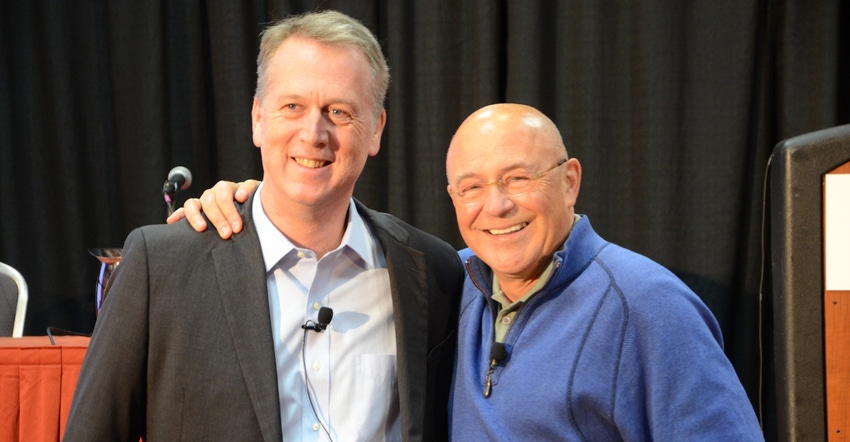March 8, 2017

Bayer is buying Monsanto. The process continues as more paperwork gets filed and each of the countries that have a say get to weigh in. Leaders of the two firms continue with confidence that the whole deal could be wrapped up by the end of the year. If so, what might that mean?
Adrian Percy, who heads up tech for Bayer Cropscience and Robb Fraley, chief technology officer, Monsanto, shared the "podium" during a brief conference during the recent Commodity Classic. The two are competitors, and as Fraley made clear, "we remain competitors" until the transaction is complete. But what might the combined company's look like, and what might they be able to do as a single entity in the market.
Percy looked at the herbicide tolerance systems on the market, and noted that there's potential there. "We have a great suite of herbicides," he noted. "But coordination was never enabled between herbicide development and trait development."
He explained that often a crop protection product would come to market and the trait technology to maximize that tech would come to market a decade later. "With this combination we'll be able to co-develop on one side the trait and on the other side the herbicide," he noted.
This is critical with rising concern over weed resistance issues, which Percy added is not just a U.S. phenomenon, but a problem in Brazil, Europe and Australia.
And it appears that the $1.6 billion in 'synergy' to be realized by the acquisition won't be happening in research. Percy pointed out that the combined research and development arm of a Bayer/Monsanto combo would have 10,000 researchers, technicians and scientists at work - 5,000 from each company. And research spending will top $2.5 billion, which he said is necessary to help growers "meet the issues they face in the field. We need innovation to help drive greater food production."
Fraley pointed to innovation in agriculture and the pace of change. "We know as a company that the opportunity with all the innovation inside the ag space is tremendouse," he said. "On the digital ag side there are sensors, satellites and we needed to invest more to bring these innovations to farmers."
He admitted that when Bayer made its offer to buy Monsanto he did some head shaking, but after reviewing the proposal and what Bayer offered he said he had to admire their capabilities. "It will allow us to invest more, invest smarter and bring integrated solutions together," Fraley added.
Answering questions
During the Q&A period, a question of wheat development came up. Both companies have wheat investments. "Wheat is an area that this potential merger can really accelerate," he said. "We have a wheat program, a seed base and a hybridization system on track for the 2020s. And we have a very extensive wheat chemistry portfolio."
He noted that Monsanto also has a wheat program and that bringing them together could accelerate the innovation for the cereals market.
Fraley called out wheat as an example of how the combination could make a difference since neither company's individual programs were at the level of investment for wheat separately needed for future success. "I'm excited about it. Wheat needs new tech and the tech is there and we can apply it. I think there is synergy from this combination.
As for progress on the merger itself? Percy explained that it is a marathon, not a sprint. The acquisition needs approval from 30 authorities and regulatory packages have been submitted to about 20 of those so far. "It's all on track, and we anticipate closing by the end of the year," Percy said.
Percy noted that regulators in the U.S., European Union and China are asking similar questions about the acquisition.
Added Fraley: "One of the strengths is that these are complementary businesses, not overlapping and that we can increase innovation and competition. This is good for the industry and good for farmers."
When seed companies come together there can be concerns about access to technology, but Fraley put that to rest for now noting that both companies have a broad and open licensing strategy and Percy and Fraley don't see that changing.
"Licensing germplasm and traits has brought success to our business; we're doing the same with data science tools and the Climate platform working with a number of equipment companies and retailers," Fraley said. "Growers are much better served with this approach. We work with different brands, and colors of equipment. The farmer has the choice for their purchase from different suppliers."
About the Author(s)
You May Also Like






